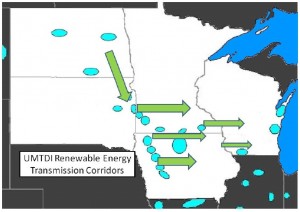UMTDI Transmission coming soon?!?!?!
September 30th, 2010
But wait… it’s already here!
Just in from Bob Cupit, from the Upper Midwest Transmission Development Initiative:
Here’s the initial idea:
The RGOS first-mover subset located within the UMTDI states’ footprint is:
• Big Stone, SD to Brookings, SD 345kV – estimated cost of $150 million.
• Brookings, SD to Twin Cities, MN 345kV – estimated cost of $700 million.
• Lakefield Junction, MN to Mitchell County, IA operated at 345kV but constructed at 765kV specifications to allow full upgrading and operation at 765kV in the future – estimated cost of $600 million.
• North La Crosse, WI to North Madison, WI and Dubuque, IA to Spring Green, WI to Cardinal, WI 345kV – estimated cost of $811 million.
• Sheldon, IA to Webster, IA to Hazleton, IA 345kV – estimated cost of $458 million.
In addition to the proposed transmission projects above, the Midwest ISO’s Midwest Transmission Expansion Plan (MTEP) for 2011 identifies the following transmission project as an initial candidate for regional cost sharing because of its regional benefits.
• Ellendale, ND to Big Stone, SD 345 kV – estimated cost of $275 million.
OK, folks, do any of these lines look familiar? Why is the CapX 2020 Brookings SD to Twin Cities MN 345kV line on this list? Why is the CapX/ATC North LaCrosse, WI to North Madison, WI on this list? Hmmmmmmmmmm…yet they say this:
Although UMTDI actively engaged in the identification of possible renewable resource areas and potential transmission corridors, this should not be taken as expression of support for particular routes, particular projects, particular voltages, or appropriate levels of spending in any state proceeding. Those decisions remain for a future day, when specific projects might be proposed. However, the Executive Committee sees great value in affirming its support for coordinated state efforts on these multi-state projects, and its general support for these corridors, which appear to have value in all identified reasonable futures.
Um… hello, they’re listing specific proposed projects.
Of course it’s all connected, how stupid do they think we are? Well, pretty damn stupid, look what they’re recommending, cost-sharing to shift the cost across MISO:
A key, unresolved issue for construction of projects of this magnitude is cost sharing. The criteria in the Midwest ISO’s recent tariff filing at FERC, as well as other activities ongoing at the Midwest ISO, indicate that these first-mover projects would likely all qualify for cost allocation treatment. This designation would mean that all energy users in the Midwest ISO’s footprint would share the costs of these “no regrets” lines. FERC has not approved this rate treatment, however, and it is likely that FERC will receive a number of comments and objections to the Midwest ISO’s tariff proposal. While the UMTDI Executive Committee has not taken a position on the Midwest ISO’s cost allocation filing, it is safe to say that the absence of cost sharing would make construction of EHV transmission lines in these corridors very difficult.
And PJM too:
The total cost for these first-mover lines is approximately $5.8 billion with $1.4 billion being funded by customers in PJM, the Midwest ISO’s neighboring independent system operator to the east.
And because they know this isn’t needed or wanted, they’re frantically trying to find a way to circumvent state authority — how about a multi-state regulatory body to site transmission… or direction to the states from FERC to act:
States Together
Interstate Compacts At the highest levels, all five states have the power to create a compact, with the consent of Congress, to establish a common agreement on how to develop the UMTDI Project. Minnesota and Wisconsin provide specific powers to their respective governors to enter compacts involving transmission lines. Congress has specifically contemplated the compact mechanism by authorizing three or more states to form a compact, subject to Congressional approval to “facilitate siting of future electric energy transmission facilities.” Sec. 216(i) of the Federal Power Act (FPA), 16 U.S.C. § 824p. Another FPA provision, little used § 209, authorizes the FERC to delegate any subject matter in its jurisdiction to a group of states, offering another potential avenue of federal approval for joint state action on transmission siting and cost allocation.
…”little used § 209″… how perverted can we get? Perhaps there’s a reason why a state PUC would be reluctant to permit projects like this?!?!?!?
